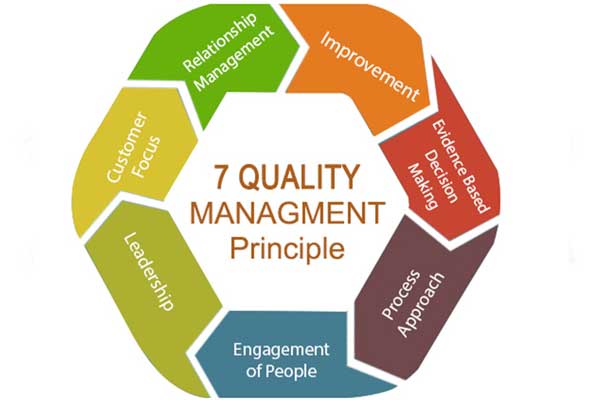The reason why ISO 9001 is so efficient at helping companies consistently deliver high-quality goods or services and exceed customer expectations is its seven quality principles. The standard amalgamates these principles in such a manner that the Quality Management System (QMS) is customised as per the unique needs of the target audience and a culture of quality improvement is fostered within the organisation. Let us look at the principles of ISO 9001.
What is a quality principle?
One of the simplest definitions of a quality principle is that it is a basic rule, a theory of belief that influences the manner in which operations related to quality are carried out. These quality management principles are values that are accepted as the absolute truth and are utilised as a foundation for creating quality management activities.

What are the seven quality management principles of ISO 9001?
The following quality management principles are not listed in order of priority or relative importance. Organisations have the freedom to choose whichever principle is most relevant to them. These include:
- Customer focus: The primary aim of a QMS is to meet and exceed customer requirements. When you implement a customer focus, it leads to sustained success and retains the confidence of the customers as well as other interested parties. Key benefits of including a customer focus in your organisation are increased customer value, increased customer satisfaction, improved customer loyalty, repeated business, enhanced reputation, expanded customer base and increased revenue. To implement customer focus into your organisation, understand customers’ current and future needs by linking organisational objectives to these expectations.
- Leadership commitment: The purpose of this quality principle is that the top management should establish unity of purpose and strategic direction in the organisation. The rationale behind this quality management principle is that it aligns the strategies, policies, processes and resources with the QMS so that it organically achieves its objectives. The key benefits include better coordination of processes, increased effectiveness, and improved communication. To implement this principle, leaders must inspire, encourage and recognise people’s contributions.
- Engagement of people: The purpose of this principle is to enhance the capability of the staff to create and deliver value. The rationale is to recognise, empower and enhance the competence of the staff through regular engagement. Key benefits include an improved understanding of the organisation’s quality objectives, enhanced involvement of people, enhanced personal development, enhanced people satisfaction and increased attention to shared value. The actions you must take include conducting surveys to assess people’s satisfaction.
- Process approach: The process approach leads to consistent and predictable results. The rationale behind this principle is that it enables an organisation to optimise the system by understanding how results are produced. Key benefits include optimised performance, predictable and consistent outcomes and consistency. To implement this approach, you must define the objectives of the system and develop the processes necessary to achieve these objectives.
- Improvement: The rationale behind this principle is that improvement is vital for an organisation to maintain current levels of performance and to react adequately to changes in its internal or external conditions. The key benefits of focusing on continual improvement include enhanced focus on root-cause investigation, improved process performance and enhanced drive for innovation. To implement this principle, it is necessary to periodically conduct audits.
- Evidence-based decision-making: The rationale behind this principle is that decisions that are based on analysis and evaluation are more likely to produce desired results. The key benefits include improved assessment of process performance, improved operational effectiveness and increased ability to adapt. To implement evidence-based decision-making, it is necessary to determine, measure and monitor key indicators that demonstrate the organisation’s performance adequately.
- Relationship management: For success to be sustained, an organisation must manage its relationship with all interested parties. The key benefits from appropriate relationship management include the enhanced performance of the organisation in the supply chain, a common understanding of goals and an increased capability to create value. To implement relationship management, you must establish collaborative development and improvement activities with suppliers, partners and other interested parties.

The cost to get ISO 9001 certification in Australia
Quality management systems cost around $4000 for small and medium-sized companies in Australia, however, the actual cost will be calculated after the consultant/auditor reviews the size, scope and complexity of your organisation.
To test how well the organisation has implemented the seven quality management principles into its operations, it is necessary to conduct regular internal audits. This routine evaluation can help assess the effectiveness of the QMS and the overall performance of the organisation. The ISO 9001 internal audit takes place when an assigned auditor evaluates the processes related to the QMS based on the criteria outlined in the standard.
Also read: “how much does it cost to get iso 9001 certification australia”
Conclusion
The seven quality management principles are customer focus, leadership, engagement of people, process approach, continual improvement, relationship management and evidence-based decision-making.
Our proficient and experienced consultants can help you check the efficiency of your quality management, improve its strength and eliminate its weaknesses. Our role is to guide your business on the successful path to ISO certification without straining or overburdening you. We pride ourselves in our ability to minimise the hassles in achieving compliance with your QMS through our services like internal audits, readiness reviews and gap analysis.








Users Comments
Get a
Quote